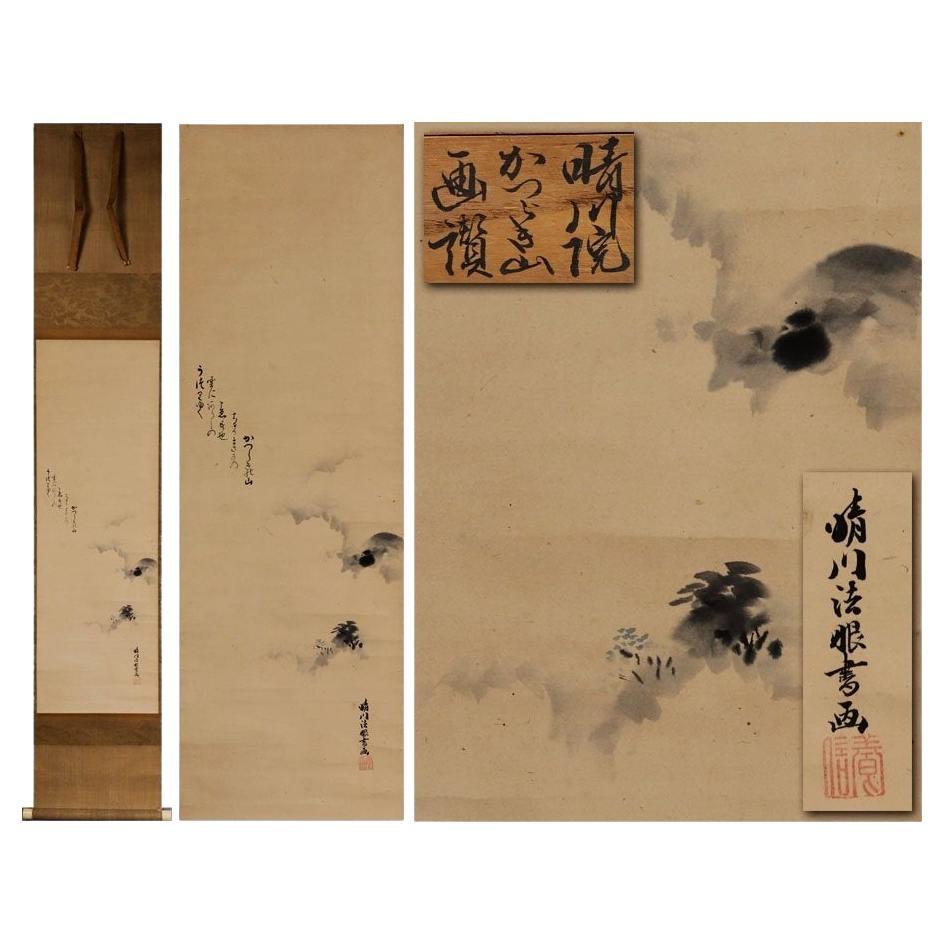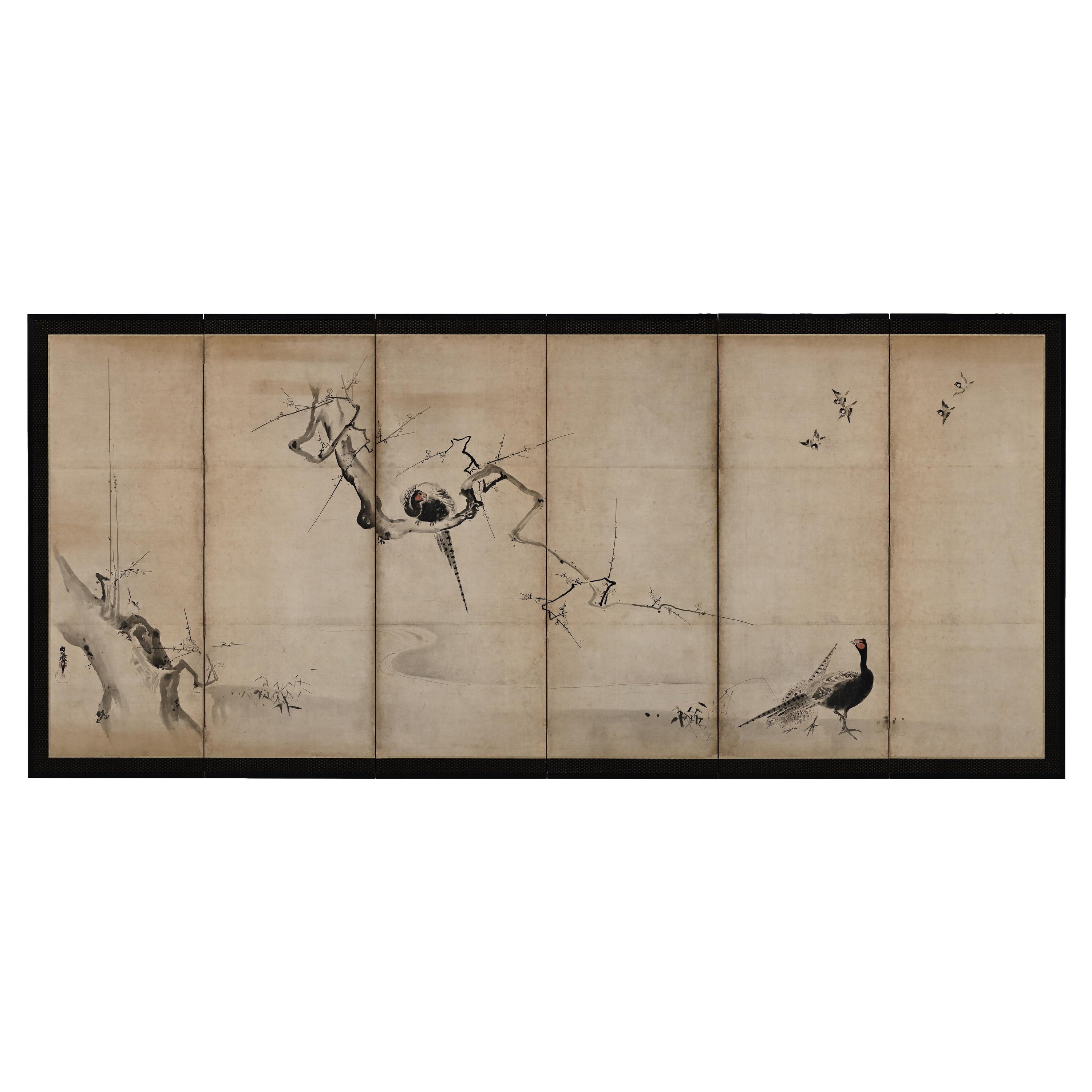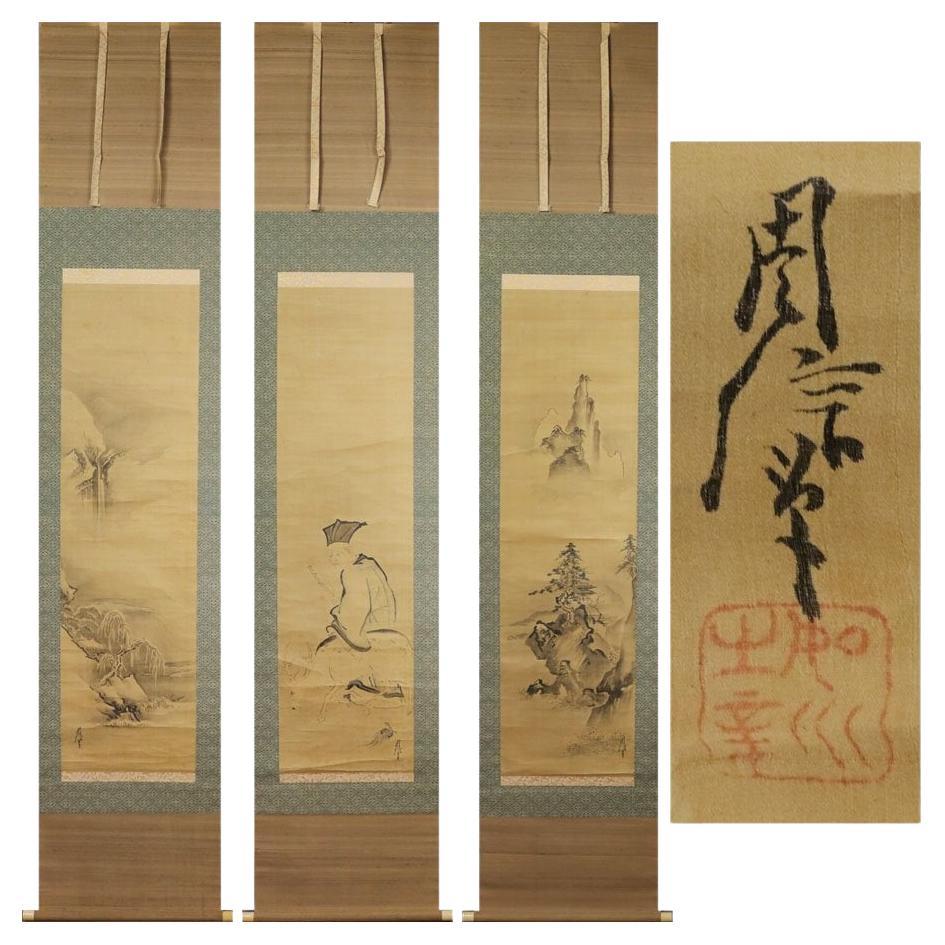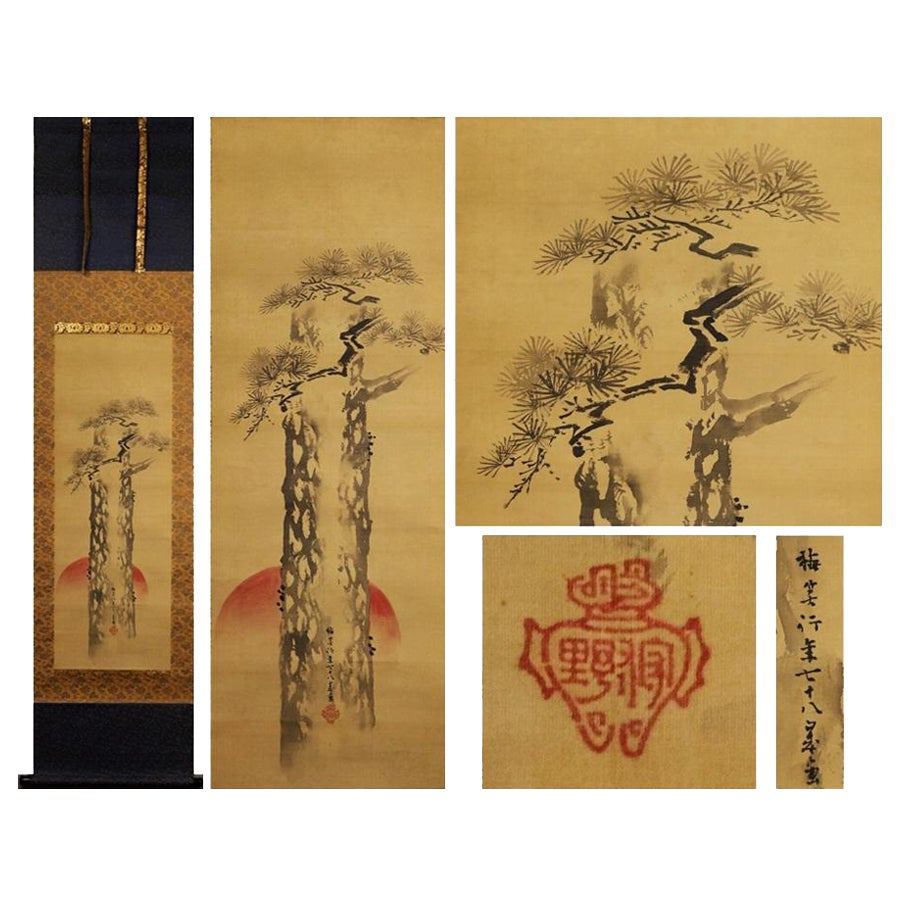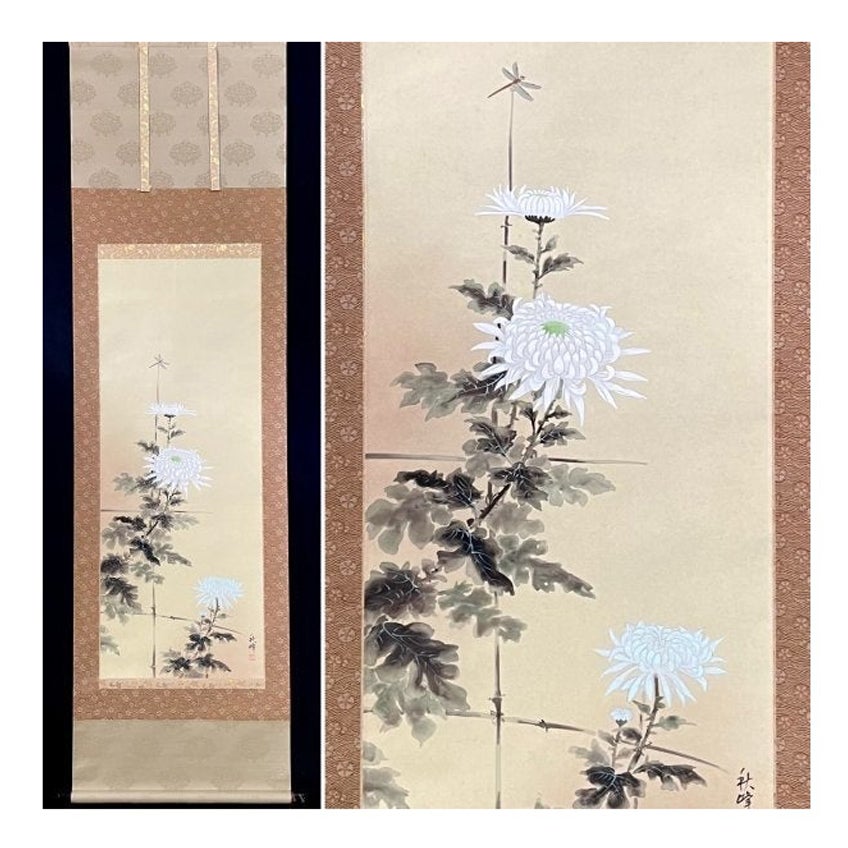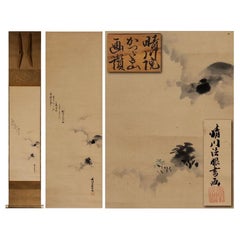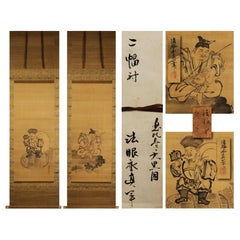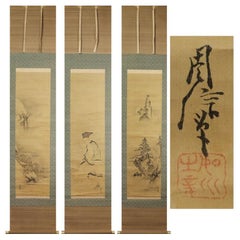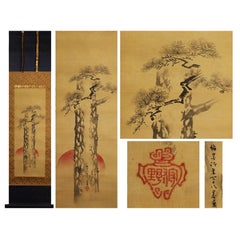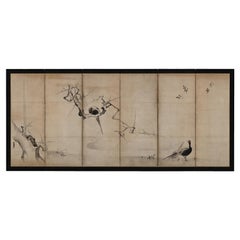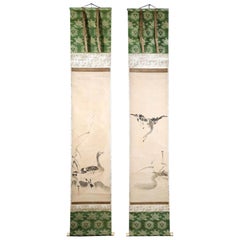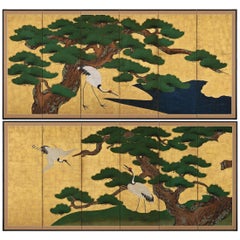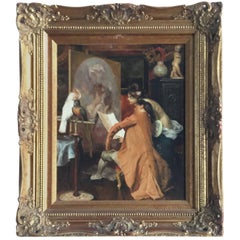Items Similar to Lovely Japanese Painting 17th c Scroll by Kanō Naonobu Nihonga Cranes Japan
Want more images or videos?
Request additional images or videos from the seller
1 of 6
Lovely Japanese Painting 17th c Scroll by Kanō Naonobu Nihonga Cranes Japan
About the Item
Lovely painting by Naonobu Kano, one of the great masters of the Kano school.It depicts a smiling parent and child, and is an auspicious design, so it would be great to hang it during New Year's or auspicious occasions. I think it looks superb
《 Naonobu Kano 》
Separate issue: Jitekisai, Jikisai. Common name: Main horse.
He is Takanobu's second son, his older brother is Tanyu and his younger brother Anma.
He became the art studio of the second Tokugawa shogun Hidetada and established the Kobikicho Kano family.
At that time, he was a master next to Tan'yu.
Died in 1650. He is 44 years old.
■Silk book, handpainted
■Condition:
There is some discoloration due to the age.
■Dimensions
Axis dimensions: approx. 187.5cm x approx. 47.5cm.
Main paper dimensions: approx. 109.5cm x approx. 35.0cm.
■Inscriptions
There are inscriptions and inscriptions, etc. as shown.
■Box
box.
- Dimensions:Height: 73.82 in (187.5 cm)Width: 18.71 in (47.5 cm)Depth: 0.04 in (1 mm)
- Materials and Techniques:
- Period:
- Date of Manufacture:1640
- Condition:Wear consistent with age and use.
- Seller Location:Amsterdam, NL
- Reference Number:Seller: 1001stDibs: LU4863236975722
About the Seller
5.0
Platinum Seller
Premium sellers with a 4.7+ rating and 24-hour response times
Established in 2015
1stDibs seller since 2019
236 sales on 1stDibs
Typical response time: 1 hour
- ShippingRetrieving quote...Shipping from: Amsterdam, Netherlands
- Return Policy
Authenticity Guarantee
In the unlikely event there’s an issue with an item’s authenticity, contact us within 1 year for a full refund. DetailsMoney-Back Guarantee
If your item is not as described, is damaged in transit, or does not arrive, contact us within 7 days for a full refund. Details24-Hour Cancellation
You have a 24-hour grace period in which to reconsider your purchase, with no questions asked.Vetted Professional Sellers
Our world-class sellers must adhere to strict standards for service and quality, maintaining the integrity of our listings.Price-Match Guarantee
If you find that a seller listed the same item for a lower price elsewhere, we’ll match it.Trusted Global Delivery
Our best-in-class carrier network provides specialized shipping options worldwide, including custom delivery.More From This Seller
View AllLovely Japanese 18/19th c Edo Scroll Kano Osanobu Nihonga Painting Mountain
Located in Amsterdam, Noord Holland
Kano Osanobu (狩野養信)
Osanobu Kano (born August 18, 1796; died June 12, 1846) was the ninth painter of the Kobikicho Kano School in the Edo period. His common name was Shozaburo. His father was Naganobu KANO, and Tadanobu KANO was his son. His Go (pen name) was Osanobu Seisenin, Kaishinsai, and Gyokusen.
Brief Personal History
He was born the eldest son of Naganobu ISENIN during the Edo period. He was first sent to serve at Edo Castle at the age of 15, and it appears that he was apparently pushed by his father to perform various public tasks for the Kanon School. He kept a diary for 36 years, starting from the day before he first went into service at Edo Castle until the day before he died. The diary is entitles "Official Service Diary" (it consists of 52 volumes that are maintained at the Tokyo National Museum, and 4 volumes that are separately maintained at the different families), and have become the focus of a lot of attention in recent years for the detailed information they present on the daily life and work of a prestigious official painter. The reading of the characters of his name was originally "Takenobu"; however, with the birth of the first son of the Shongun Ieyoshi TOKUGAWA in 1813, whose name was Takechiyo, having a sylable with the same pronunciation of "Take"was deemed to be inappropriate, and was therefore changed to "Osanobu". Because Takenobu died the following year, after which he was referred to as Gyokujuin, Osanobu changed his pen name Gyokusen he had used until that point to Seisenin, in order to avoid using the same Chinese charcter pronounced alike. In 1819, he attained the second highest rank for a Buddhist priest, Hogen, and assumed the role of head of the family after his father passed away in 1828. In 1834 he attained the highest rank for a Buddhist priest, Hoin. He oversaw the rennovation of the wall paintings of Nishinomaru Palace of Edo Castle from 1838 to 1839, and Honmaru Palace of it from 1844 to 1846. It is thought that Osanobu later died due to the fatigue...
Category
Antique 18th Century Edo Paintings
Materials
Silk
$1,669 Sale Price
20% Off
Antique Japanese 17th c Edo Scroll Kano Yosanobu Buddhist Painting
Located in Amsterdam, Noord Holland
Eishin Kano's Ebisu/Great Country Map, double-width/comes with an old box.
The auspicious statues of Ebisu and Daikoku are standing in a double-width hanging scroll with a smiling fa...
Category
Antique 18th Century Edo Paintings
Materials
Silk
$3,341 Sale Price
20% Off
Japanese Painting 17th c Edo Scroll Triptyque Kano Chikanobu Buddhist Painting
Located in Amsterdam, Noord Holland
TheItem below was painted approximately 300 years ago by Kano Chikanobu. In the center is a depiction of a deer hermit, on the right is a landscape of a tower that gives a sense of ...
Category
Antique 17th Century Edo Paintings
Materials
Silk
$3,341 Sale Price
20% Off
Antique Japanese 18th c Edo Scroll [Kano Baisho Nihonga Landscape Painting
Located in Amsterdam, Noord Holland
This is a ``Rising Sun and Pine Tree'' drawn by Kano Baisho.
It is an item with a solemn taste and presence, and I think it would be a good idea to display it at New Year's, the fir...
Category
Antique 18th Century Edo Paintings
Materials
Silk
$3,341 Sale Price
20% Off
Lovely Japanese 20th c Scroll Chrysanthemum Nihonga Flower
Located in Amsterdam, Noord Holland
This work carefully and delicately depicts a Chrysanthemum
■Silk book, handwritten
■Condition
Lovely Condition
■Dimensions
Axis size: 1855mm (height) x 530mm (width)
Paper size: ...
Category
20th Century Paintings
Materials
Silk
$453 Sale Price
20% Off
Lovely Japanese 20th c Scroll Pommegranate Nihonga Flower
Located in Amsterdam, Noord Holland
This work carefully and delicately depicts a Chrysanthemum
■Silk book, handwritten
■Condition
Lovely Condition
■Dimensions
Axis size: 1840 mm (height) x 535 mm (width)
Paper size...
Category
20th Century Paintings
Materials
Silk
$453 Sale Price
20% Off
You May Also Like
17th Century Japanese Screen. Ink Plum Tree & Birds by Kano Naonobu.
Located in Kyoto, JP
Kano Naonobu (1607-1650)
Plum Tree and Birds
Six-fold Japanese Screen. Ink and slight color on paper.
In this evocative ink work spread over a six-panel folding screen, we see the consummation of the elegance and refinement of the Edo Kano school. This 17th century screen is a rare surviving example of a large-scale bird and flower painting by Kano Naonobu, the younger brother of Kano Tanyu...
Category
Antique 17th Century Japanese Edo Paintings and Screens
Materials
Wood, Paper
Pair of Japanese Ink Hanging Scrolls Kano Tanyu
By Kano Tan'yu 1
Located in Atlanta, GA
A fine matching pair of hanging scrolls ink on paper mounted in green brocade borders circa Edo period (17-18th century). The Kano school painting depicts wild geese in the reeds by the margin of water, a popular subject borrowed from the Chinese tradition. Both painting were signed as Tanyu with a red seal of Morinobu, his birth name. The storage box is also present and was inscribed with the title Painting of Geese and Reeds and Kano Tanyu...
Category
Antique Late 17th Century Japanese Japonisme Paintings and Screens
Materials
Wood, Paper
$6,000 / set
Circa 1700 Japanese Screen Pair, Cranes & Pines, Kyoto Kano School
Located in Kyoto, JP
Pines and Cranes
Anonymous. Kyoto Kano School.
Late 17th/early 18th centuries, circa 1700.
Pair of six-panel Japanese folding screens.
Ink, gofun, pigment and gold leaf on paper.
This bold composition presents two pine trees extending to the left and right across a gold leaf background. One tree is silhouetted against a green ground, golden clouds obscuring its true size, the other stretches across a stylized waterway. The pines are paired with Manchurian cranes with red crests and snow white plumage. Both have been highly auspicious motifs in East Asia since Chinese antiquity. Here the artist utilized fluid and instinctive ink brushstrokes to define the trunk, branches and tail feathers, in strong contrast to the precision and sharp angularity of the crane’s legs and beaks. The adoption of this vast metallic painting support required an unerring sense of design and composition, so that the negative space surrounding motifs could imply context for the otherwise floating pictorial elements. The brushwork detailing the trunks of the pines, the exaggerated dimensions of the pine trees and the strength and dynamism of the composition are all reminiscent of Kano Eitoku...
Category
Antique Late 17th Century Japanese Edo Paintings and Screens
Materials
Gold Leaf
17th Century Painting
Located in Miami, FL
17th century painting
J.Castano
17th century
Spain
Category
Antique 17th Century Baroque Paintings
Materials
Canvas
$25,000
Japanese Painting, Framed Panel, 17th Century Falcon by Mitani Toshuku
By Mitani Toshuku
Located in Kyoto, JP
Mitani Toshuku (1577-1654)
“Falcon”
Wall panel, ink and light color on paper.
Upper seal: Mitani
Lower seal: Toshuku
Dimensions:
Each 118.5 cm x 51 cm x 2 cm (46.5” x 20” x .75”)
Individual falcon paintings by Mitani Toshuku (1577-1654), an early artist of the Unkoku School. Founded by Unkoku Togan (1547–1618), a master of the Momoyama period, the Unkoku school enjoyed long lasting patronage in southern Japan. Togan was a retainer of the Mori family in present day Yamaguchi prefecture. Members of the school considered themselves to be in the artistic lineage of Sesshu Toyo...
Category
Antique Early 17th Century Japanese Edo Paintings and Screens
Materials
Wood, Paper
19th Century Japanese Silk Painting by Kano Chikanobu, Phoenix & Paulownia
Located in Kyoto, JP
Birds & Flowers of the seasons
Pheasants & Plum in Snow
Unframed painting. Ink, pigment and gofun on silk
Kano Chikanobu 1819-1888
Signature...
Category
Antique Mid-19th Century Asian Edo Paintings and Screens
Materials
Silk
